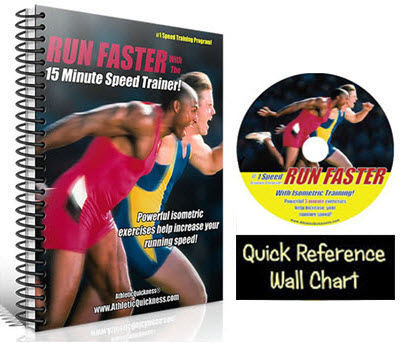and outPerform in
every sport
What is Isometrics Training

The 3 Types of Muscle Contractions Concentric, Eccentric, and Isometric
Your speed training program will deliver your best sports performance when you train your muscles with all three!
Part 4 of 4 – Isometrics
Part 1 – Muscle Contraction Types
Part 2 – Weight Lifting
Part 3 – Plyometrics
Part 4 – Isometrics
In this section, I’m discussing several different types of isometric exercises and define which types of muscle contractions are involved in the exercise, and why that exercise is important to overall athletic performance.
Isometric Training
Isometric training exercises are unique for several reasons. First, they are the only type of exercise where the type of muscle contraction is identified by name. Many times we hear people wanting to compare plyometric training with isometric training, and weight training with isometric training, but this not reasonable.. This is because you are trying to compare a type of exercise (weightlifting and/or plyometrics and/or cardio, etc.) with a type of muscle contraction.
Weightlifting and plyometrics, as well as cardio exercises for that matter, primarily involve concentric and eccentric muscle contractions. Isometric exercises, have isometric contractions, which as you may already know, are a type of muscle contraction where muscles undergo tension but do not change length in any direction.
Isometric exercises are also unique in that they are generally much safer than other types of exercises. Sometimes this limits their effectiveness, while other times it enhances it. And, until recently, many people associated isometric training with weights only as the resistance aid, and this also minimized their effectiveness.
With new resistance tools and more creative exercise strategies, isometric training is demonstrating every day that it can target those hard-to-get-at muscles very effectively and that other strategies simply cannot.
But for the purposes of this article, we are only going to describe you some of the age-old isometric exercises that your parents were probably taught. The modern day version, with resistance bands, and unique athlete positioning will have to wait!
Isometric Biceps Curl with Weight
Take a 20 pound weight and perform a biceps curl. Hold a position halfway between the repetition for 10 seconds. The length of your biceps muscle doesn’t change during this time. A force is still being applied.
Wall Push
Push against a wall for 10 seconds. The wall doesn’t move and neither does the length of the muscles in your arms pushing against it. Again, a force is still being applied.
Bench Press
Get on a weightlifting bench and grab hold of the bar with whatever weight you are comfortable with. Lower the weight to a point in your repetition where you feel you are at your weakest. Hold the bar at that position for 7-10 seconds. The bar doesn’t move and neither do the muscles in your arms and chest. A force is still being applied.
Isometric exercises have been around for a long time and so it is nothing new. Many extraordinary results in muscle size and strength have been achieved in a very short period of time with this type of training. However, because of the number of new training products and techniques out on the market today, its use by athletes is often overlooked.
No Training Program Is Complete Without Isometrics
As we stated in the first section, no training program would be considered complete without incorporating, to some extent, each of the three different types of muscle contractions mentioned thus far.
Plyos and weights are great because they involve eccentric and concentric contractions. They are extremely beneficial for size and strength, and in some cases this added strength transfers over into speed.
Since many athletes are already doing these types, they are probably hitting plateaus because they are still missing the third type of muscle contraction, isometric.
When they apply the strategy of isometrics with the resistance band to their existing routines, the completion of all three contraction types within an exercise program has an exponential effect on their performance, especially improved speed and quickness!
Always glad to help!
Dr. Larry Van Such
Part 1 – Muscle Contraction Types
Part 2 – Weight Lifting
Part 3 – Plyometrics
Part 4 – Isometrics

About the Author of this post: Dr. VanSuch is a chiropractor and former electrical engineer. He developed the speed training method that uses resistance bands with an isometric training strategy to help athletes run faster starting way back in 1996. He has been teaching this technique to athletes, coaches and parents for the last 25+ years and has quite an extensive list of testimonials found throughout this website. Dr. VanSuch’s speed training programs are for running, kicking, jumping as well as swinging a golf club, baseball bat or tennis racket. He also has written an MMA speed program. Athletes of all fitness levels have used his training method with great success. He looks forward to hearing from all those who come across his work and are wanting to learn more. Feel free to contact him at support@athleticquickness.com
Comments are closed.
How to Become Faster Than Ever!
- How to Train for Speed ----------------
- Resistance Band Exercises for Speed ----------------
- How to Train Fast Twitch Muscle Fibers ----------------
- How to Get Faster Running Speed ----------------
- Football Speed Training --------------
- Baseball Speed Training --------------
- Golf Swing Speed Exercises
Get Your Own Speed Training Program.
NFL Cornerback Sprints Fastest 40 Ever!

Mark Parson
NFL Cornerback Runs Fastest 40 After One Week of TrainingBreaking Records

Anthony Chesson
Breaks 200m Southern Classic record set by NFL Pro-BowlerBecomes 2 Time All American!

Darrell Wesh
ACC 200m Gold Medal
HS 60m National Champion
2 Time Collegiate All American
Goes From 2nd String Sub to State Honors!

Mick Baker
Smallest player, batting 4th, leads team to Iowa State Championship, Named Tournament RBI Leader







